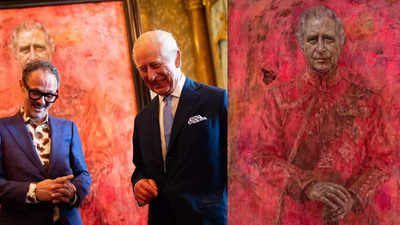- News
- World News
- Europe News
- 'Is he bathing in blood?': Netizens see red after Charles' portrait unveiled
Trending
'Is he bathing in blood?': Netizens see red after Charles' portrait unveiled

Royal portraits, as a rule, tend to be fairly staid, predictable affairs. Full of symbolism, sure, but generally symbolism of the traditional, establishment kind: symbols of state, of office, of pomp and lineage. Which is why the new official portrait of King Charles III by Jonathan Yeo, the first since the king's coronation, has created such a controversy.
A larger-than-life (7.5 feet by 5.5 feet) canvas, the portrait shows the king standing in his Welsh Guards uniform, hands on the hilt of his sword, a half-smile on his face, with a butterfly hovering just over his right shoulder.His entire body is bathed in a sea of crimson, so his face appears to be floating.
Although the butterfly was apparently the key piece of semiology - meant, Yeo told the BBC, to represent Charles' metamorphosis from prince to sovereign and his long-standing love of the environment - it was the painting's primary colour that almost instantaneously gave new meaning to the idea of "seeing red." It was practically begging for interpretation. "To me it gives the message the monarchy is going up in flames or the king is burning in hell," one commentator wrote under the royal family's Instagram post when the portrait was unveiled. "It looks like he's bathing in blood," another wrote. Someone else raised the idea of "colonial bloodshed." There were comparisons to the devil. And so on. There was even a mention of the Tampax affair, a reference to an infamous comment by Charles revealed when his phone was hacked during the demise of his marriage to Diana, Princess of Wales.
In his interview with the BBC, Yeo noted that when the king first saw the painting, he was "initially mildly surprised by the strong colour". Yeo said his goal was to produce a more modern royal portrait, reflecting Charles' desire to be a more modern monarch. Still, the choice of shade seems particularly fraught given the firestorm the king has endured since his ascension to the throne. Consider, for example, the continued falling out with his second son, Prince Harry, and the publication of Harry's memoir, with its allegations of royal racism; the related calls for an end to the monarchy; Charles' cancer diagnosis; and the furore over the mystery about Catherine, Princess of Wales, whose own cancer diagnosis was revealed only after increasingly unhinged speculation about her disappearance from public life.
A larger-than-life (7.5 feet by 5.5 feet) canvas, the portrait shows the king standing in his Welsh Guards uniform, hands on the hilt of his sword, a half-smile on his face, with a butterfly hovering just over his right shoulder.His entire body is bathed in a sea of crimson, so his face appears to be floating.
Although the butterfly was apparently the key piece of semiology - meant, Yeo told the BBC, to represent Charles' metamorphosis from prince to sovereign and his long-standing love of the environment - it was the painting's primary colour that almost instantaneously gave new meaning to the idea of "seeing red." It was practically begging for interpretation. "To me it gives the message the monarchy is going up in flames or the king is burning in hell," one commentator wrote under the royal family's Instagram post when the portrait was unveiled. "It looks like he's bathing in blood," another wrote. Someone else raised the idea of "colonial bloodshed." There were comparisons to the devil. And so on. There was even a mention of the Tampax affair, a reference to an infamous comment by Charles revealed when his phone was hacked during the demise of his marriage to Diana, Princess of Wales.
In his interview with the BBC, Yeo noted that when the king first saw the painting, he was "initially mildly surprised by the strong colour". Yeo said his goal was to produce a more modern royal portrait, reflecting Charles' desire to be a more modern monarch. Still, the choice of shade seems particularly fraught given the firestorm the king has endured since his ascension to the throne. Consider, for example, the continued falling out with his second son, Prince Harry, and the publication of Harry's memoir, with its allegations of royal racism; the related calls for an end to the monarchy; Charles' cancer diagnosis; and the furore over the mystery about Catherine, Princess of Wales, whose own cancer diagnosis was revealed only after increasingly unhinged speculation about her disappearance from public life.
It's hard to imagine Yeo didn't anticipate some of the reaction to the portrait. Indeed, the last time a royal portraitist attempted a more abstract, contemporary interpretation of their subject - a 1998 portrait of Queen Elizabeth II by Justin Mortimer, which depicted the queen against a neon yellow background with a splash of yellow bisecting her neck - it produced a similar public outcry. The Daily Mail, at the time, had accused the artist of cutting off the queen's head. NYT
End of Article
FOLLOW US ON SOCIAL MEDIA










